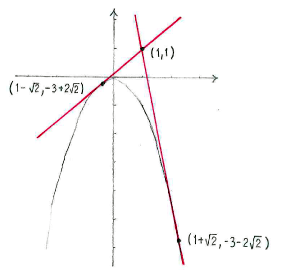Lösung 1.1:5
Aus Online Mathematik Brückenkurs 2
| (Der Versionsvergleich bezieht 6 dazwischen liegende Versionen mit ein.) | |||
| Zeile 1: | Zeile 1: | ||
| - | Wir nehmen an dass die Tangente(n) die Kurve im Punkt <math>(x_0,y_0)</math> | + | Wir nehmen an, dass die Tangente(n) die Kurve im Punkt <math>(x_0,y_0)</math> berührt. Dieser Punkt liegt natürlich auf der Kurve, erfüllt also |
{{Abgesetzte Formel||<math>y_0 = -x_0^2\,\textrm{.}</math>|(1)}} | {{Abgesetzte Formel||<math>y_0 = -x_0^2\,\textrm{.}</math>|(1)}} | ||
| - | Schreiben wir die Tangente | + | Schreiben wir die Tangente als <math>y=kx+m</math>, ist die Steigung ''k'' dasselbe wie die Ableitung <math>y^{\,\prime} = -2x</math> an der Stelle <math>x=x_0</math>. |
| - | {{Abgesetzte Formel||<math>k = -2x_0\,\textrm{ | + | {{Abgesetzte Formel||<math>k = -2x_0\,\textrm{}</math>|(2)}} |
| - | Die | + | Die Bedingung, dass die Tangente durch den Punkt <math>(x_0,y_0)</math> geht, gibt |
{{Abgesetzte Formel||<math>y_{0} = k\cdot x_0 + m\,\textrm{.}</math>|(3)}} | {{Abgesetzte Formel||<math>y_{0} = k\cdot x_0 + m\,\textrm{.}</math>|(3)}} | ||
| - | + | Die Bedingung dass die Tangente durch den Punkt (1,1) geht, gibt | |
{{Abgesetzte Formel||<math>1 = k\cdot 1 + m\,\textrm{.}</math>|(4)}} | {{Abgesetzte Formel||<math>1 = k\cdot 1 + m\,\textrm{.}</math>|(4)}} | ||
| Zeile 17: | Zeile 17: | ||
Die Gleichungen (1)-(4) sind ein System von Gleichungen mit den unbekannten <math>x_0</math>, <math>y_{0}</math>, <math>k</math> und <math>m</math>. | Die Gleichungen (1)-(4) sind ein System von Gleichungen mit den unbekannten <math>x_0</math>, <math>y_{0}</math>, <math>k</math> und <math>m</math>. | ||
| - | + | Da wir <math>x_0</math> und <math>y_0</math> suchen, eliminieren wir zuerst ''k'' und ''m''. | |
| - | + | Aus der Gleichung (2) folgt, dass <math>k = -2 x_0</math>. Das in Gleichung (4) eingesetzt, liefert | |
{{Abgesetzte Formel||<math>1 = -2x_0 + m\quad\Leftrightarrow\quad m = 2x_0+1\,\textrm{.}</math>}} | {{Abgesetzte Formel||<math>1 = -2x_0 + m\quad\Leftrightarrow\quad m = 2x_0+1\,\textrm{.}</math>}} | ||
| - | Jetzt haben wir ''k'' | + | Jetzt haben wir ''k'' und ''m'' in Termen von <math>x_0</math> und <math>y_0</math> ausgedrückt und Gleichung (3) hat nun nur <math>x_0</math>- |
| - | und <math>y_0</math>-Terme | + | und <math>y_0</math>-Terme. |
| - | {{Abgesetzte Formel||<math>y_0 = -2x_0^2 + 2x_0 + 1\,\textrm{ | + | {{Abgesetzte Formel||<math>y_0 = -2x_0^2 + 2x_0 + 1\,\textrm{}</math>|(3')}} |
| - | Diese Gleichung | + | Diese Gleichung und die Gleichung (1) bilden ein Gleichungssystem für <math>x_0</math> und <math>y_0</math>. |
{{Abgesetzte Formel||<math>\left\{\begin{align} | {{Abgesetzte Formel||<math>\left\{\begin{align} | ||
y_{0} &= -x_0^{2}\,,\\[5pt] | y_{0} &= -x_0^{2}\,,\\[5pt] | ||
| - | y_{0} &= -2x_0^2 + 2x_0 + 1\,\textrm{ | + | y_{0} &= -2x_0^2 + 2x_0 + 1\,\textrm{} |
\end{align}\right.</math>}} | \end{align}\right.</math>}} | ||
| - | Substituieren wir (1) | + | |
| + | Substituieren wir (1) von (3), erhalten wir eine Gleichung mit nur <math>x_0</math>. | ||
{{Abgesetzte Formel||<math>-x_0^2 = -2x_0^2 + 2x_0 + 1\,,</math>}} | {{Abgesetzte Formel||<math>-x_0^2 = -2x_0^2 + 2x_0 + 1\,,</math>}} | ||
| Zeile 45: | Zeile 46: | ||
Diese Quadratische Gleichung hat die Lösungen | Diese Quadratische Gleichung hat die Lösungen | ||
| - | {{Abgesetzte Formel||<math>x_0 = 1-\sqrt{2}\qquad\text{ | + | {{Abgesetzte Formel||<math>x_0 = 1-\sqrt{2}\qquad\text{und}\qquad x_0 = 1+\sqrt{2}\,\textrm{.}</math>}} |
| - | Durch die Gleichung (1) erhalten wir den entsprechenden ''y''-Wert | + | Durch die Gleichung (1) erhalten wir den entsprechenden ''y''-Wert |
| - | {{Abgesetzte Formel||<math>y_0 = -3+2\sqrt{2}\qquad\text{ | + | {{Abgesetzte Formel||<math>y_0 = -3+2\sqrt{2}\qquad\text{und}\qquad y_0 = -3-2\sqrt{2}\,\textrm{.}</math>}} |
Also erhalten wir die Punkte <math>(1-\sqrt{2},-3+2\sqrt{2})</math> und | Also erhalten wir die Punkte <math>(1-\sqrt{2},-3+2\sqrt{2})</math> und | ||
Aktuelle Version
Wir nehmen an, dass die Tangente(n) die Kurve im Punkt \displaystyle (x_0,y_0) berührt. Dieser Punkt liegt natürlich auf der Kurve, erfüllt also
| \displaystyle y_0 = -x_0^2\,\textrm{.} | (1) |
Schreiben wir die Tangente als \displaystyle y=kx+m, ist die Steigung k dasselbe wie die Ableitung \displaystyle y^{\,\prime} = -2x an der Stelle \displaystyle x=x_0.
| \displaystyle k = -2x_0\,\textrm{} | (2) |
Die Bedingung, dass die Tangente durch den Punkt \displaystyle (x_0,y_0) geht, gibt
| \displaystyle y_{0} = k\cdot x_0 + m\,\textrm{.} | (3) |
Die Bedingung dass die Tangente durch den Punkt (1,1) geht, gibt
| \displaystyle 1 = k\cdot 1 + m\,\textrm{.} | (4) |
Die Gleichungen (1)-(4) sind ein System von Gleichungen mit den unbekannten \displaystyle x_0, \displaystyle y_{0}, \displaystyle k und \displaystyle m.
Da wir \displaystyle x_0 und \displaystyle y_0 suchen, eliminieren wir zuerst k und m.
Aus der Gleichung (2) folgt, dass \displaystyle k = -2 x_0. Das in Gleichung (4) eingesetzt, liefert
| \displaystyle 1 = -2x_0 + m\quad\Leftrightarrow\quad m = 2x_0+1\,\textrm{.} |
Jetzt haben wir k und m in Termen von \displaystyle x_0 und \displaystyle y_0 ausgedrückt und Gleichung (3) hat nun nur \displaystyle x_0- und \displaystyle y_0-Terme.
| \displaystyle y_0 = -2x_0^2 + 2x_0 + 1\,\textrm{} | (3') |
Diese Gleichung und die Gleichung (1) bilden ein Gleichungssystem für \displaystyle x_0 und \displaystyle y_0.
| \displaystyle \left\{\begin{align}
y_{0} &= -x_0^{2}\,,\\[5pt] y_{0} &= -2x_0^2 + 2x_0 + 1\,\textrm{} \end{align}\right. |
Substituieren wir (1) von (3), erhalten wir eine Gleichung mit nur \displaystyle x_0.
| \displaystyle -x_0^2 = -2x_0^2 + 2x_0 + 1\,, |
also
| \displaystyle x_0^2 - 2x_0 - 1 = 0\,\textrm{.} |
Diese Quadratische Gleichung hat die Lösungen
| \displaystyle x_0 = 1-\sqrt{2}\qquad\text{und}\qquad x_0 = 1+\sqrt{2}\,\textrm{.} |
Durch die Gleichung (1) erhalten wir den entsprechenden y-Wert
| \displaystyle y_0 = -3+2\sqrt{2}\qquad\text{und}\qquad y_0 = -3-2\sqrt{2}\,\textrm{.} |
Also erhalten wir die Punkte \displaystyle (1-\sqrt{2},-3+2\sqrt{2}) und \displaystyle (1+\sqrt{2},-3-2\sqrt{2})\,.

